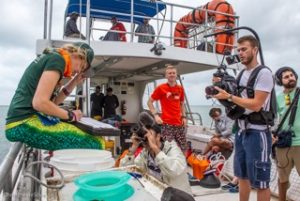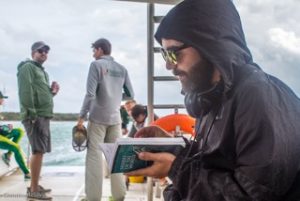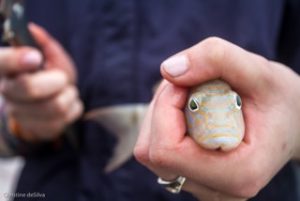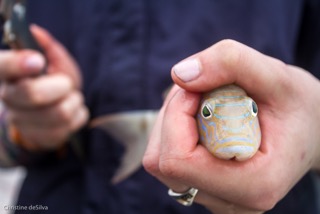National Geographic Filming: Day 1
By Julia Whidden, SRC Intern
On February 15th, a crew of 8 SRC members and 7 National Geographic filmmakers merged together for a 3-day tagging excursion in search of the Ferraris of the ocean: the great hammerhead shark (Sphyrna mokarran). With cloudy skies and a slim chance of rain, we made brief introductions and set off together from Diver’s Paradise at Crandon marina to the shallow waters of Cape Florida Channel. Spoiler alert: we got skunked.

SRC Intern Shannon Moorehead being filmed recording data.
While the etiology of the fishing term ‘skunked’ is debatable, most anglers can agree that catching no fish – oh, the irony – stinks. It was a first for many of the SRC interns on the boat that day, including myself, but we remained hopeful as we pulled in each of the 45 lines set that this next line would be the one. We baited our circle hooks with bonito (of the tuna family Scombridae) and barracuda (of the barracuda family Sphyraenidae, and the 1977 hit by Heart), and had several lines come up with the bait nearly intact! The sharks just weren’t ready for their on-screen close-up. The film crew used their free time to record us doing the less glamorous side of shark fishing, including cutting bait, organizing tools in our beloved “FatMax” toolbox, setting and retrieving (empty) drumlines, recording data, performing interpretive shark dances, and the fishing highlight of our day: retrieving the fish traps. At the beginning of most shark trips, we set out 2 baited fish traps near our fishing site to investigate the species assemblage of the area, or what fish our sharks may be feeding on. Today we baited both traps with cross-hatched jack, which we cut into to release juices and draw in nearby fish. After soaking for nearly 5 hours, we retrieved the 2 traps to find a combined 4 fish, including 2 white grunts, a juvenile redtail parrotfish, and a Houdini fish that escaped my slippery grip before we could identify it. From both a fishing and filming perspective, the day ended quite anticlimactically. However, we took the time to get to know the film crew, and the film crew took some time to learn about obscure and underappreciated sharks, thanks to SRC Intern Rachel Skubel having brought along her copy of “Sharks of the World”. While sound engineer Eddy’s newfound knowledge of lanternsharks did not prove useful over the rest of the trips, the chance to become friends with the film crew on our quiet first day was really valuable. Besides the obvious benefit of knowing someone before you end up in a confined space with them and a shark, talking to the film crew gave me the chance to ask questions about the holy grail of nature journalism that is National Geographic. Having grown up with the magazine being a staple of my family’s coffee table selection, I was beyond thrilled to be even somewhat involved with them, and mentally checked off “do work with Nat Geo” from my bucket list. As it turns out, getting skunked wasn’t so bad after all.

Film crew sound engineer Eddy reading about the sharks we weren’t catching in “Sharks of the World”.
At the end of the day, we had collected data about the day’s environmental variables, including water temperature, salinity, and dissolved oxygen. Even though we weren’t able to add to it with any shark data, the saying in science goes that “no data is still data”. This means that despite not having caught any sharks in the Cape Florida Channel today, we can still learn something about why the sharks weren’t there or why we weren’t able to catch them, possibly relating to seasonal movement patterns, the day’s weather, species-specific behaviors, feeding and habitat requirements, fishing location, and a variety of other factors. Our crew remained optimistic through 45 lines of empty hooks that tomorrow would bring more action, and that today was the calm before the storm! Spoiler alert: we were right.

One of the two white grunts that we caught in our fish traps, looking like he’s not happy about his impending physical exam.




Leave a Reply
Want to join the discussion?Feel free to contribute!